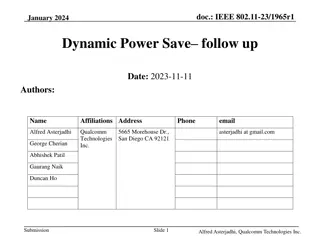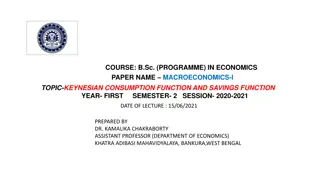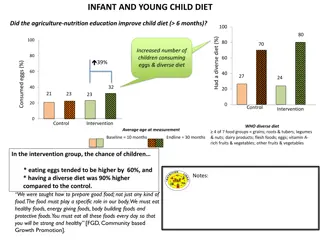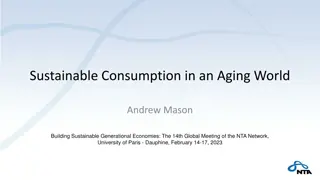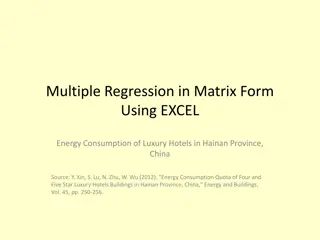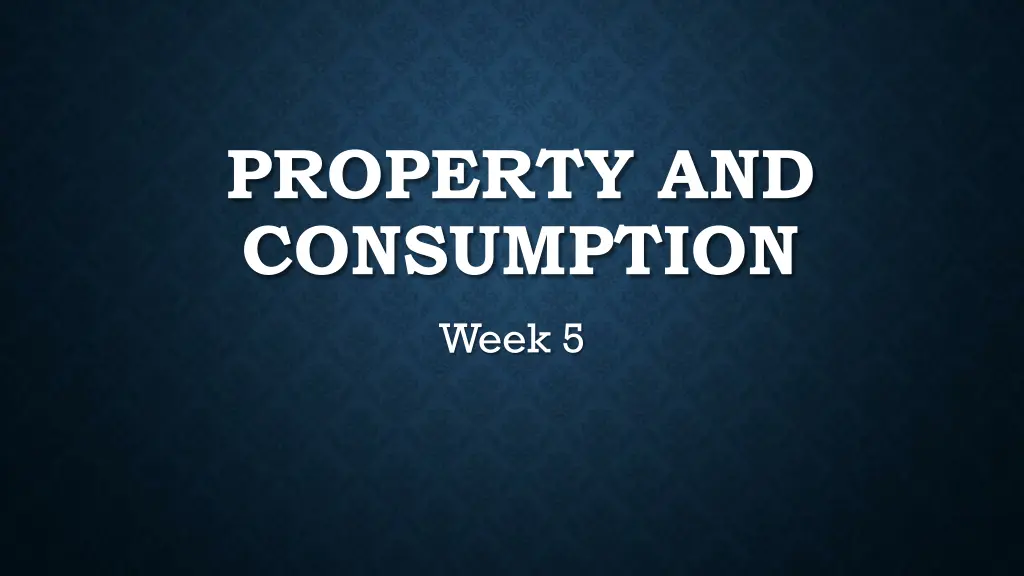
Understanding Property and Consumption Trends in History
Explore the evolution of consumer habits and its impact on the industrial revolution, gendered consumption patterns, women's property rights in the 18th and early 19th centuries, and the societal implications of changing consumer behaviors. Uncover the intersection between economic growth, social norms, and individual choices.
Download Presentation

Please find below an Image/Link to download the presentation.
The content on the website is provided AS IS for your information and personal use only. It may not be sold, licensed, or shared on other websites without obtaining consent from the author. If you encounter any issues during the download, it is possible that the publisher has removed the file from their server.
You are allowed to download the files provided on this website for personal or commercial use, subject to the condition that they are used lawfully. All files are the property of their respective owners.
The content on the website is provided AS IS for your information and personal use only. It may not be sold, licensed, or shared on other websites without obtaining consent from the author.
E N D
Presentation Transcript
PROPERTY AND CONSUMPTION Week 5
OUTLINE 1. What is the consumer revolution? 2. How did consumption fuel the industrial revolution? 3. In what ways were consumer habits gendered? 4. What were women's property rights in the 18thand early 19th centuries? 5. How did this impact on women in practice?
1. WHAT IS THE CONSUMER REVOLUTION?
1720 variety, quality and quantity of goods increased. Explosion in consumer demand (McKendrick). Cross-class development. Movement from economic prudence to capitalist mass consumption. Growth in concept of luxury .
STUDY OF CONSUMPTION: Concentration on demand counters economic historians past emphasis on production. Recent focus on widening range of commodities standard and luxuries. Look for meanings behind goods and habits objects as social signifier (Kowaleski-Wallace). Challenge origins of consumerism in 19thcentury 2 consumer revolutions.
2. HOW DID CONSUMPTION FUEL THE INDUSTRIAL REVOLUTION?
Changing household behaviour = 'industrious revolution = industrial revolution (De Vries). 1. Increasing specialisation 2. Rural families worked harder/shifted their crop mix towards marketable products/ used child and female labour to expand production of both agricultural and industrial goods 3. Households reduced leisure time to increase production and income. 4. Additional income gave purchase power/additional production meant more goods available to purchase. 5. Goods stimulate demand changing social attitudes class emulation and competition
3. IN WHAT WAYS WERE CONSUMER HABITS GENDERED?
STEREOTYPE REINFORCEMENT: Contemporaries and historians prejudiced. Women: obsessed by material goods, lacking self control, parasitic. Men: producers and breadwinners. Money equated with male worth, women squandering money seen as emasculating. Feminists suspicious of commodities: fashion viewed negatively as emblematic of women's decorative dependence.
George Brummell Robert de Montesquiou THE DANDY. Amann, Dandyism in the Age of Revolution (2015)
SHOPPING IS A STATE OF MIND NOT PHYSICAL COMPULSION Consuming Subject (Kowaleski-Wallace) deeper meaning to consumption. Commodities signifies social status. Identity formation and self expression: Projection, fantasy, desire; image creation. Women s bodies reconfigured in relation to consumption: denaturalise the natural .
MALE AND FEMALE CONSUMPTION PATTERNS Amanda Vickery Family Unit: diaries, letters and household account books. Men and women were both skilful consumers but of different sorts of products. While female consumption was repetitive and relatively mundane, male consumption was by contrast occasional and impulsive, or expensive and dynastic.' Stana Nenadic Edinburgh and Glasgow probate inventories. Middle classes: purchase of household objects and luxuries rare not undertaken without considerable planning. 'affectionate consumption : items which provided owners with reminders of relatives, friends past life.
L s. d. Full image of the inventory of Thomas Carr. Ref: DPRI/1/1692/C2/1 His Purse & Apparrell 00 : 07 : 06 one old Bedd Steed 00 : 02 : 06 one old Feather Bedd Pillow & two Happins 00 : 05 : 08 two Paire of Coarse Lin[en] Sheats 00 : 07 : 00 four paire of old harden Sheats 00 : 05 : 00 two Paire of old harden Pillowbers [pillowcase] 00 : 00 : 08 two old Table Cloaths & five Napkins 00 : 02 : 06 Inventory of Thomas Carr of Swallwell 1692 two old Darnick Curtons one old Vallance & Carpett 00 : 01 : 01 one Dozen & halfe of Trenchers 00 : 01 : 00 two little Panns & one pott 00 : 03 : 00 one Skeel Washing Tubb tray & one Bowle 00 : 01 : 06 Eight little old Pewter Dishes 00 : 05 : 08 two old Tanketts & one quart pott 00 : 01 : 03 one Gill pott & a Quarterne Pott 00 : 00 : 04 one Pewter Cup Salt & pewter Taster 00 : 00 : 03 one old Latten Candlstick & Six Spoons 00 : 00 : 07 one old Table & one Furr Dresser kubbert 00 : 03 : 04 two Joint Stoolls & two Furr Chaires 00 : 00 : 09 one little hanging Shelfe & small firr box 00 : 00 : 06 one small looking Glass & an old Pickter 00 : 00 : 09 three Wood Dishes & an old Salt kitt 00 : 00 : 04 one old fire Shovell porr & Tongues 00 : 00 : 07 one Diging Spade & an Ax 00 : 01 : 00 one how & a small Crow of Iron 00 : 01 : 00 one old Bible & little Sermon Book 00 : 01 : 01 02 : 14 : 10
Lorna Weatherill: Probate inventories reveal consumption predominantly functional not fashionable. (John Brewer & Roy Porter, Consumption and the World of Goods) Social Status Cooking pots Pewter Earthenware Books Clocks Pictures Table Linen China Silver Gentry 84 93 39 39 51 33 60 6 61 Trades of high status 75 95 53 45 34 35 63 11 51 Trades of intermediate status 77 94 49 24 25 29 58 9 38 Yeomen 69 95 33 18 19 4 35 1 13 Trades of low status 74 96 42 17 18 15 50 3 23 Husbandmen 57 89 28 4 4 0 16 0 2 Labourers 79 89 43 4 0 4 18 4 0 Widows/Spinsters 66 89 33 18 13 12 46 4 37 Other trades 82 88 50 32 29 32 61 11 46 Unknown 70 88 27 17 14 18 40 5 23 Total 70 93 37 19 19 13 42 4 23
4. WHAT WERE WOMEN'S PROPERTY RIGHTS IN THE 18TH AND EARLY 19TH CENTURIES?
5. HOW DID THIS IMPACT ON WOMEN IN PRACTICE?
COVERTURE All personal property belonging to a woman at marriage belonged to her husband absolutely. Exception was paraphernalia - clothing and personal ornaments remained a wife s possession. A married woman could enter no contracts in her own name but could enter into contracts in her husband's name as his agent. Law of agency: woman could pledge her husband's credit with tradesmen for the supply of necessaries suitable to their station in life. The items normally considered necessaries were food, lodging, clothing, medical attendance and medicines Law of equity: Trusts established for wealthy women by husband/father.
WIFE SALES Informal divorce. Women were property. Often agreed before hand by husband and wife s new partner. Freed a wife and children from following husband to debtors prison or workhouse. Public announcement to traders and shopkeepers that wife no longer accessing his credit.
WILLS Evidence of women's property in wills. Women also bequeathed personal property in their own wills. Women's goods were often emotionally significant to them: the clothing women left was frequently described in some detail, including colour and type of cloth. Of women leaving wills in Birmingham and Sheffield around 47% owned land or houses. In Birmingham nearly three-quarters owned more than one piece of land or property.
CONCLUSIONS Consumer revolution/industrious revolution brought explosion in the types and range of goods women and men possessed. 2 Consumer revolution: habits and environment. Research challenges previously accepted gender stereotypes of male producer and female consumer. While early historians such as Davidoff and Hall focused on fact that married women could own no property, recent research focuses on gulf between legal theory and practice. 1882 Married Women s Property Act: Married women had same rights over their property as unmarried women. Wives retained property gifted by parents. 1893 Married Women's Property Act: Wives retained property owned before marriage or acquired after marriage by inheritance or earnings.



